

3-D Printed Buildings Coming Soon to a Moon Near You. A multi-dome moon base being constructed.

The top left and middle domes are completed, while you can see robots in process of building the top and bottom-right domes. Visualization courtesy European Space Agency. New Nuclear Engine Could Power Deep-Space Exploration. Researchers have tested a small prototype of a nuclear-reactor engine design that could one day power deep-space exploration probes.
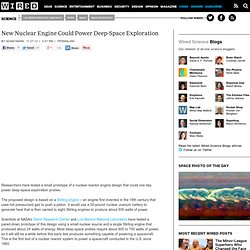
The proposed design is based on a Stirling engine – an engine first invented in the 19th century that uses hot pressurized gas to push a piston. It would use a 50-pound nuclear uranium battery to generate heat that is then carried to eight Stirling engines to produce about 500 watts of power. 100 Year Starship Study. Home - Mars One. Private Plan to Send Humans to Mars in 2018 Might Not Be So Crazy.
Image: Inspiration Mars Foundation An ambitious private manned mission to Mars aims to launch a two-person crew to fly around the Red Planet and return to Earth in 501 days, starting in January 2018.

This bold undertaking is planned by the Inspiration Mars Foundation, a non-profit company founded by millionaire and space tourist Dennis Tito that was officially unveiled on Feb. 27 after early details leaked. Future Mars Astronauts May Be Sleepy, Bored and Crabby. Future astronauts going to Mars could have trouble sleeping, become lethargic, and have problems with mental tasks over the course of a long mission.
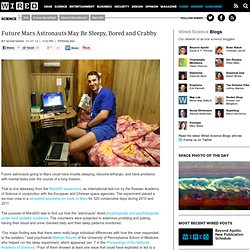
That is one takeaway from the Mars500 experiment, an international test run by the Russian Academy of Science in conjunction with the European and Chinese space agencies. The experiment placed a six-man crew in a simulated spaceship en route to Mars for 520 consecutive days during 2010 and 2011. The purpose of Mars500 was to find out how the “astronauts” fared physiologically and psychologically under such isolated conditions. The volunteers were subjected to extensive prodding and poking, having their blood and urine checked daily and their sleep patterns monitored. Help Wanted: Astronauts Needed for Mars Colony. SIDÉRAL – Aller-simple pour Mars : la sélection des Terriens intéressés commence dans trois mois.
Image transmise par Mars One le 21 juin 2012, montrant la future implantation humaine prévue sur Mars dès 2023. Mars One était , mardi 4 décembre, qu'elle se transforme en société à but non lucratif . Dans son communiqué , repéré par le site Slashdot , l'entreprise se targue de multiples soutiens – entreprises spécialisées du monde entier, scientifiques de la NASA ou encore un physicien prix Nobel –, et défend un projet aussi ambitieux que prompt : la sélection des candidats pour Mars commence dès le mois de mars prochain, l'envoi des modules habitables, des vivres et de robots entre 2016 et 2022... et le débarquement des premiers humains sur la planète rouge, en 2023. Mars One dit avoir déjà reçu un millier de candidatures. Après sélection, entraînement et sept mois de trajet, les quatre premiers astronautes seront suivis de quatre autres tous les deux ans, jusqu'à atteindre vingt Terriens en 2033.
Cette entrée a été publiée dans Actualité . Solar Power Sail Demonstrator "IKAROS"|JAXA Space Exploration Center. A Solar Sail converts sunlight as a propulsion by means of a large membrane while a Solar "Power" Sail gets electricity from thin film solar cells on the membrane in addition to acceleration by solar radiation.

What's more, if the ion-propulsion engines with high specific impulse are driven by such solar cells, it can become a "hybrid" engine that is combined with photon acceleration to realize fuel-effective and flexible missions. To evaluate the performance of the solar power sails, IKAROS (Interplanetary Kite-craft Accelerated by Radiation Of the Sun) was launched on May 21, 2010 together with the Venus Climate Orbiter, AKATSUKI And IKAROS becomes the world's first solar powered sail craft employing both photon propulsion and thin film solar power generation during its interplanetary cruise.
IKAROS leaflet(PDF:1MB) Operation summary get the larger view. Elon Musk wants SpaceX to help establish a colony on Mars. Photo by NICHOLAS KAMM/AFP/Getty Images At a small Future Tense gathering last night, Elon Musk—he of PayPal, Tesla Motors, and SpaceX—discussed the privatization of space travel and exploration with Robert Wright, host of “The Wright Show” on Slate.
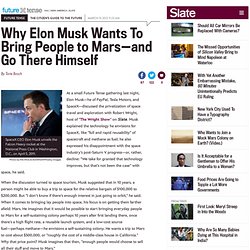
Musk explained the technology he envisions for SpaceX, like “full and rapid reusability” of spacecraft and methane as fuel; he also expressed his disappointment with the space industry’s post-Saturn V progress—or, rather, decline: “We take for granted that technology improves, but that’s not been the case” with space, he said. When the discussion turned to space tourism, Musk suggested that in 10 years, a person might be able to buy a trip to space for the relative bargain of $100,000 to $200,000. Elon Musk and Spacex work put $500,000 per person trips to Mars for 2023 to 2028. NASA researcher Kevin Parkin discusses microwave space propulsion. In an interview with Sander Olson, Kevin Parkin, the Deputy Director of the Mission Design Center at NASA Ames, discusses the potential benefits of using microwave power to send payloads to orbit.
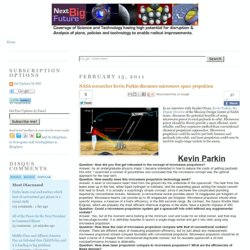
Microwave power should in theory provide a more efficient, more reliable, and less expensive method than conventional chemical propulsion approaches. Microwave propulsion could be used to put both humans and payloads into orbit, and laser propulsion could even be used for single-stage rockets to the moon. Answer: As an undergraduate physics major, I became interested in how to reduce the costs of getting payloads into orbit. I examined a number of possibilities and concluded that the microwave concept was the optimal approach for the near term. Answer: A laser or microwave beam fired from the ground hits the underside of the spacecraft. Answer: Yes, but at the moment we’re looking at the minimum cost and scale for an initial rocket, and that may be two-stage-to-orbit. Answer: Definitely. Koroteev at the heart of Russia's Megawatt nuclear reactor for space plans. The role of space power in solving prospective problems in the interests of global safety, science and social economic sphere by А.S.
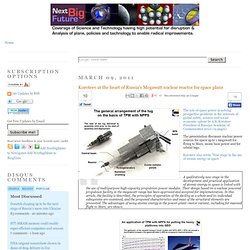
Koroteev President of Russian Academy of Cosmonautics 2010 (19 pages) Minimag for near term interstellar transportation. The full "Use of Mini-Mag Orion and superconducting coils for near-term interstellar transportation" paper is available for free online (2007, 9 pages) I had previously suggested avoiding the 1000 Terawatt laser of the interstellar minimag by predeploying the fuel along the path of the minimag.

Pacman gobbling up dots Interstellar transportation to nearby star systems over periods shorter than the human lifetime requires speeds in the range of 0.1–0.15 c and relatively high accelerations. These speeds are not attainable using rockets, even with advanced fusion engines because at these velocities, the energy density of the spacecraft approaches the energy density of the fuel. Russia, NASA to hold talks on nuclear-powered spacecraft. UK Register - Russia, the US and other nations are to discuss cooperation on building a nuclear-powered spacecraft, according to the head of Roscosmos – the Russian space agency.
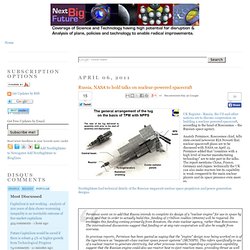
Anatoly Perminov, Roscosmos chief, tells state-owned newswire RIA Novosti that nuclear spacecraft plans are to be discussed with NASA on April 15. Perminov added that "countries with a high level of reactor manufacturing technology" are to take part in the talks. The report mentions China, France, Germany and Japan: technically the UK can also make reactors but its capability is weak compared to the main nuclear players and its space presence even more so. Nextbigfuture had technical details of the Russian megawatt nuclear space propulsion and power generation designs. Before this decade is out there will be a boom in sending people into space.
Heinlein Style Spaceflight with Supertall Towers—and '2001' Style Space Development. Si le septième ciel existe, vous vous y rendrez dans cet ascenseur. Ce projet complétement fou est annoncé par la firme Obayashi Corp. Les dirigeants ont confirmé leur intention de construire un ascenseur spatial capable de faire la navette sur … 36 000 kilomètres ! C’est estomaquant. Pour construire ce monstre de science-fiction, les ingénieurs prévoient d’utiliser des nanotubes de carbone 20 fois plus résistants que l’acier et étirés sur 96 000 kilomètres.
Une extrémité du câble serait alors ancrée à un port spatial, tandis que l’autre serait équipée d’un contrepoids. Pour vous donner un ordre d’idée, cela correspond à environ un quart de la distance Terre-Lune. Le terminus de cet ascenseur sera donc une sorte de station de travail placée au pallier des 36 000 kilomètres. Un employé d’Obayashi Corp a déclaré qu’il était pour le moment impossible de budgéter un tel projet. Island Three. Artist's depiction of a pair of O'Neill cylinders The O'Neill cylinder (also called an O'Neill colony) is a space settlement design proposed by American physicist Gerard K. O'Neill in his 1976 book The High Frontier: Human Colonies in Space.[1] O'Neill proposed the colonization of space for the 21st century, using materials extracted from the Moon and later from asteroids.[2] Interior view, showing alternating land and window stripes Background[edit]